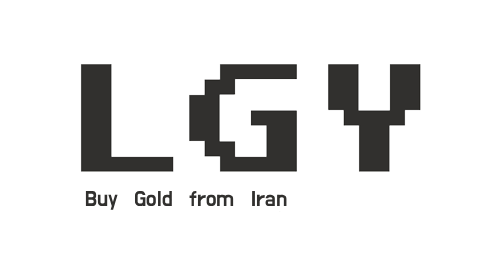
Iranian Jewelry as a Cultural Heritage
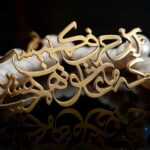
The Impact of Persian Poetry and Literature on Jewelry Design
A Guide to Iranian Bridal Jewelry Traditions: Exploring Regional Variations in Bridal Adornments
Iranian bridal jewelry traditions are as rich and diverse as the country’s culture, with each region showcasing its unique styles and customs. Across Iran’s provinces, brides wear elaborate gold, silver, and stone-adorned jewelry that reflects both their cultural heritage and personal status. These traditional pieces not only add beauty but also carry symbolic meanings, often related to protection, prosperity, and family honor.
In this guide, we’ll explore the types of bridal jewelry worn by brides in different regions of Iran, highlighting the styles, materials, and cultural significance that make these adornments such an integral part of Iranian wedding traditions.
1. Tehran and Central Iran: Elegance and Modern Sophistication
In Tehran, the capital of Iran, and other parts of Central Iran, bridal jewelry tends to combine traditional gold pieces with a modern aesthetic. Brides here are often adorned with intricate gold sets, including necklaces, earrings, bracelets, and rings, reflecting both luxury and sophistication.
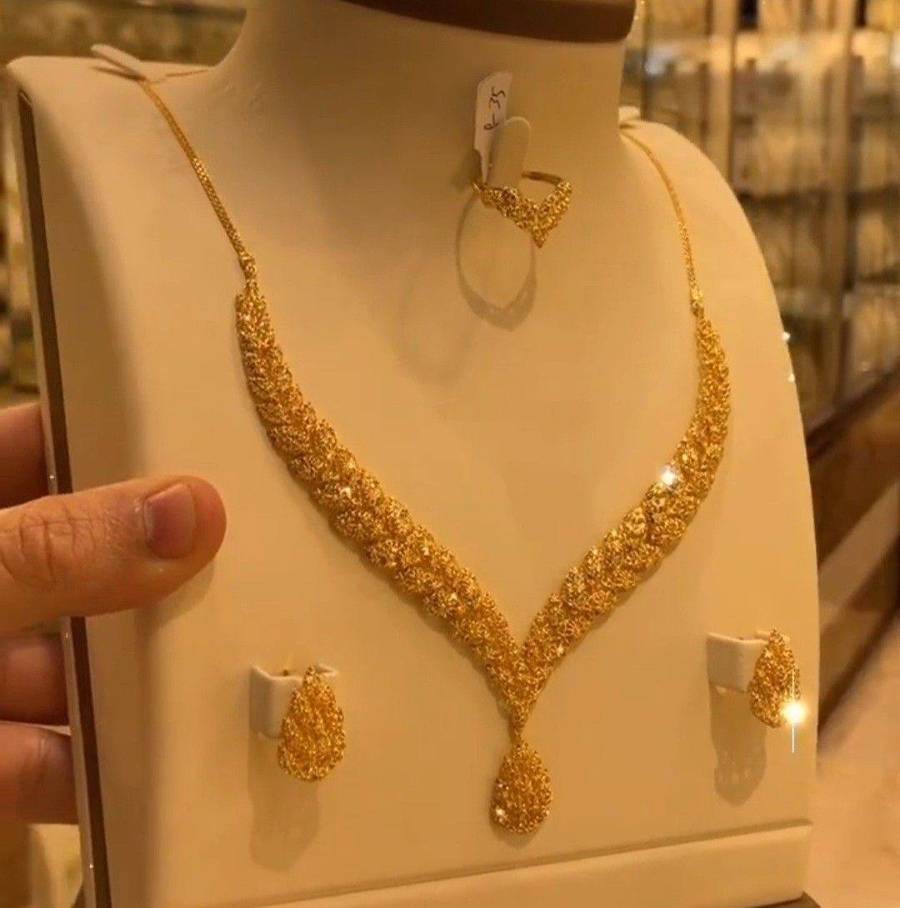
Gold Necklace Sets
Key Jewelry Pieces
- Gold Necklace Sets: These typically feature filigree work, diamond accents, or pearls, and are designed to match the bride’s gown. The necklace often carries symbolic meanings related to prosperity and family unity.
- Gold Bracelets and Bangles: Brides in Tehran wear gold bangles or cuff bracelets, often layered to create a dazzling effect. Some designs incorporate Persian calligraphy or floral motifs, adding a touch of cultural significance.
- Diamond or Pearl Earrings: While gold is the dominant material, diamond or pearl earrings are also popular choices in this region, offering a blend of traditional luxury and modern elegance.
Symbolism
In Central Iran, bridal jewelry is a symbol of financial security and good fortune, with gold being a traditional gift from the groom’s family to the bride. The bride’s jewelry is also meant to symbolize the family’s prosperity and status within the community.
2. Isfahan: Exquisite Enamel Work (Minakari) and Delicate Filigree
Isfahan, known as the cultural heart of Iran, is famous for its intricate Minakari (enamel work) and filigree jewelry. Brides in this region wear stunning pieces that reflect centuries-old Persian craftsmanship, showcasing both artistry and cultural heritage.
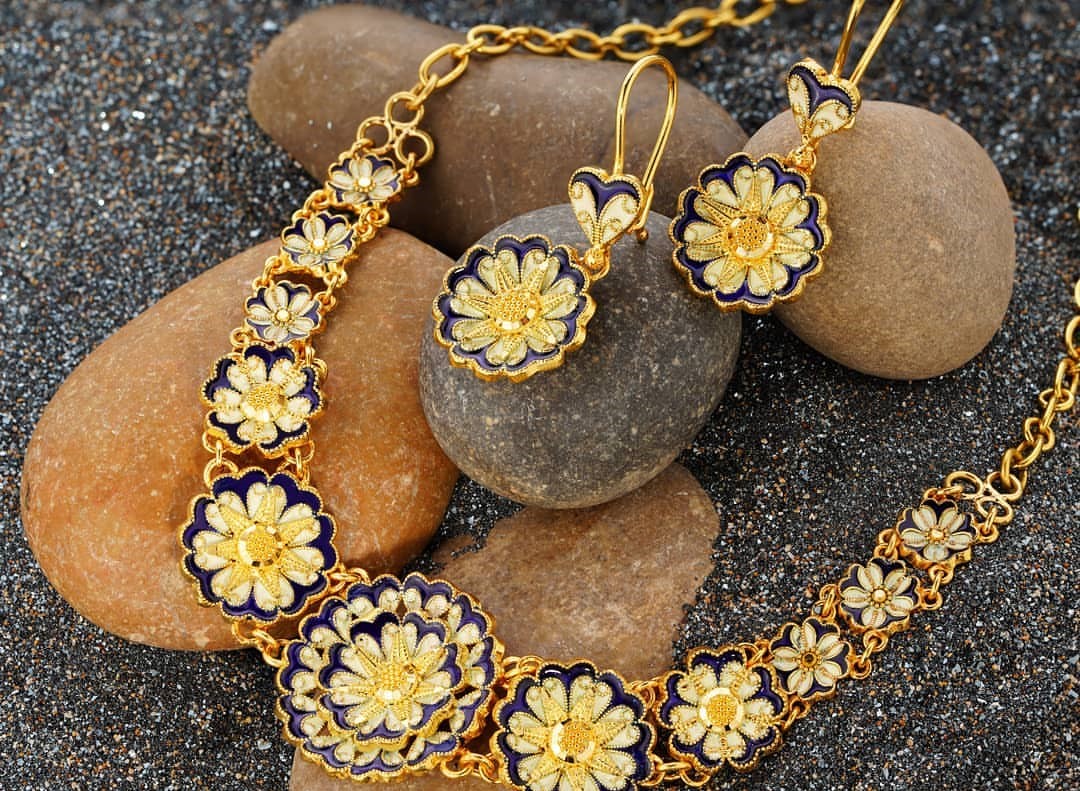
Minakari Necklaces Sets
Key Jewelry Pieces
- Minakari Necklaces: These enamel-decorated necklaces feature vibrant blues, greens, and reds, with intricate patterns inspired by Persian tilework. The colors are meant to represent nature and paradise, tying the bride to her cultural roots.
- Filigree Earrings and Bracelets: Delicate gold or silver filigree is a hallmark of Isfahan’s jewelry-making tradition. Brides wear filigree earrings and bracelets, often adorned with semi-precious stones such as turquoise and lapis lazuli.
- Silver Hair Ornaments: In addition to gold and enamel pieces, Isfahan brides may wear silver hairpins or hairpieces shaped like flowers or stars, adding an elegant touch to their wedding attire.
Symbolism
The intricate designs of Isfahani bridal jewelry are not only a testament to the bride’s elegance but also to her family’s artistic heritage. The use of enamel work and filigree reflects the long-standing traditions of Persian craftsmanship, while the colors of the stones symbolize protection and prosperity for the bride.
3. Tabriz and Northwest Iran: Bold and Ornate Gold Jewelry
In Tabriz and the surrounding areas of Northwest Iran, brides are known for wearing bold, ornate gold jewelry. The use of thick gold necklaces, large earrings, and heavy bracelets is a reflection of both the bride’s family’s wealth and their adherence to cultural traditions that value opulence in bridal adornment.
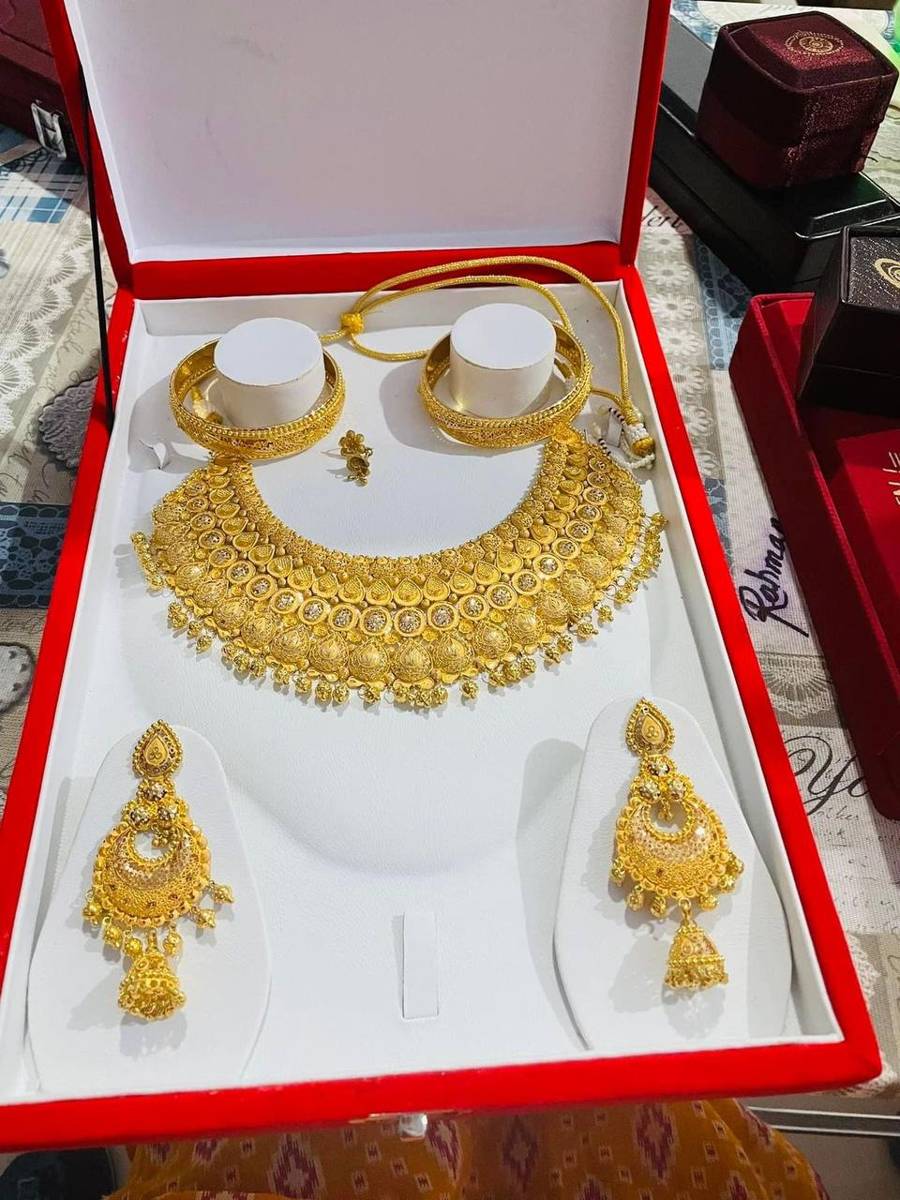
Heavy Gold Necklaces
Key Jewelry Pieces
- Heavy Gold Necklaces: Tabrizi brides often wear layered gold necklaces, featuring thick chains, pendants, and coins. These necklaces are often gifted by the groom’s family as part of the bride’s dowry, symbolizing financial security.
- Gold Coin Jewelry: The use of gold coins in necklaces, bracelets, and earrings is common in this region. These coins are seen as symbols of wealth and prosperity for the new couple.
- Gold Headpieces and Crowns: Some Tabrizi brides wear golden crowns or headpieces adorned with semi-precious stones and coins. These crowns are a nod to the region’s history of royalty and nobility, emphasizing the bride’s elevated status.
Symbolism
Gold plays a central role in the bridal traditions of Tabriz and Northwest Iran, where it is a marker of both wealth and family honor. The bride’s jewelry is meant to secure her future, symbolizing abundance and protection in her new life as a married woman.
4. Kurdistan: Silver Jewelry and Tribal Traditions
In Iranian Kurdistan, brides wear jewelry that is distinctively silver and often hand-crafted with tribal motifs. The jewelry reflects Kurdish cultural identity and is typically less ornate than the gold jewelry seen in other regions, but it carries deep symbolic meaning tied to heritage and community.
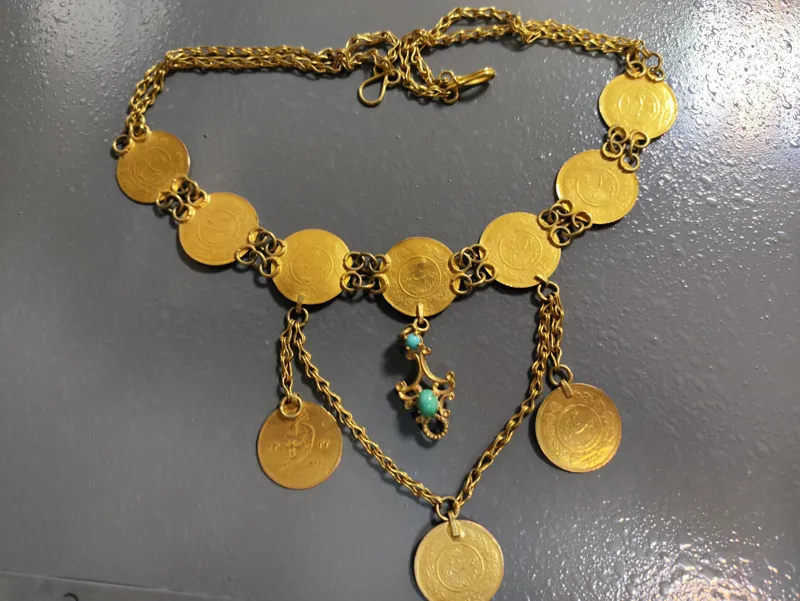
Ahmed Shah Qajar coin necklace
Key Jewelry Pieces
- Silver Belts: A signature piece in Kurdish bridal attire, the silver belt is often crafted with intricate designs and worn around the waist, symbolizing strength and fertility. These belts are highly valued and passed down through generations.
- Silver Coin Necklaces: Kurdish brides often wear silver necklaces adorned with coins, sometimes passed down from mothers or grandmothers. These coins symbolize family wealth and serve as protective charms.
- Headpieces and Hair Ornaments: Kurdish bridal attire includes silver headpieces that drape over the bride’s hair, sometimes incorporating small chains and coins. These headpieces are often adorned with tribal symbols, representing the bride’s connection to her community.
Symbolism
Silver jewelry in Kurdistan is more than just an adornment; it represents the bride’s connection to her Kurdish heritage and tribal identity. The silver coins and belts symbolize protection and strength, and the use of handcrafted pieces reflects the importance of family traditions.
5. Southern Iran: Pearl Jewelry and Coastal Traditions
In Southern Iran, particularly along the Persian Gulf coast, bridal jewelry is often crafted from pearls, reflecting the region’s history of pearl diving and trade. Brides in cities such as Bushehr and Bandar Abbas wear elegant pearl jewelry, which is a symbol of both purity and wealth.
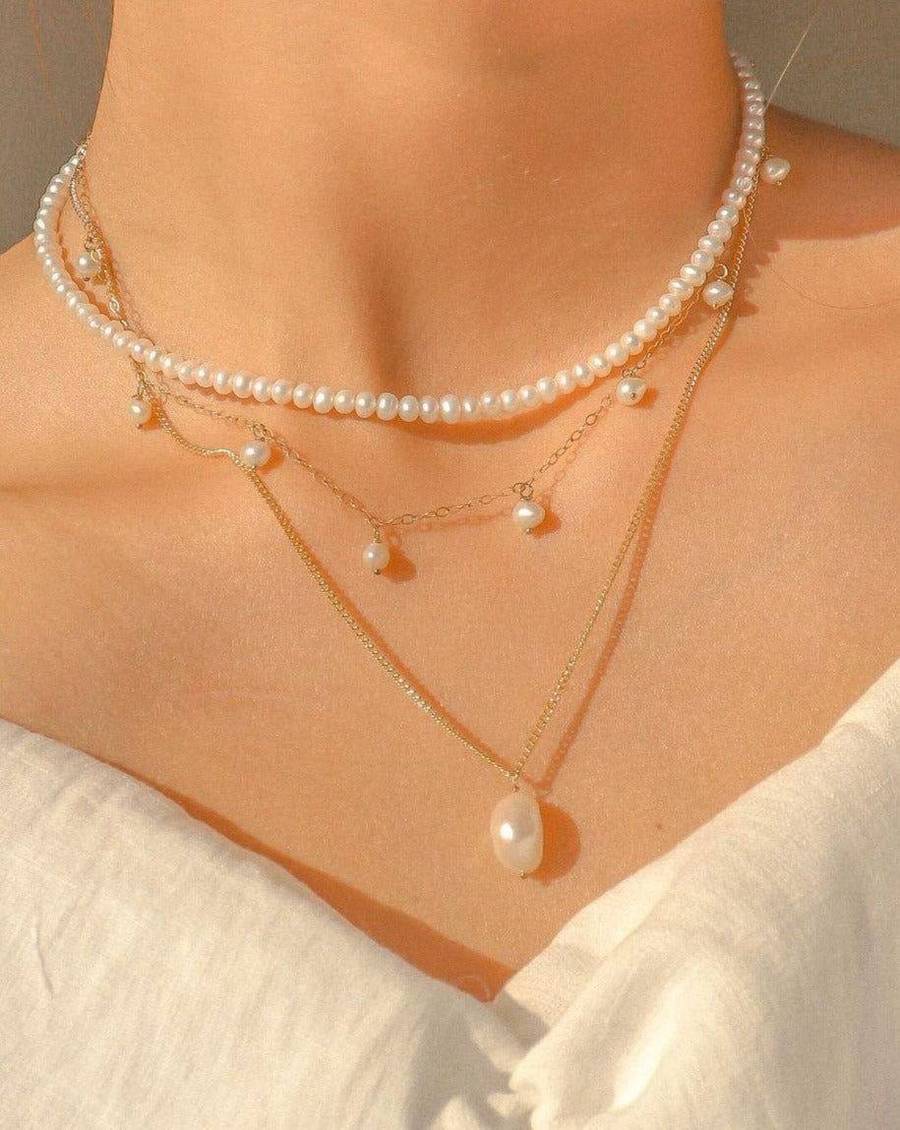
Pearl Necklaces
Key Jewelry Pieces
- Pearl Necklaces: Brides in Southern Iran often wear multi-strand pearl necklaces, featuring large, natural pearls. These necklaces can be simple or paired with gold pendants, showcasing the beauty of the pearls.
- Pearl Earrings and Bracelets: Dangling pearl earrings and bracelets are also popular among brides in this region. The pearls are often set in gold or silver, adding a touch of sophistication to the bride’s look.
- Gold and Pearl Hairpieces: In addition to traditional jewelry, some Southern brides wear gold headpieces with pearls woven into their hair, symbolizing prosperity and purity in their marriage.
Symbolism
In Southern Iran, pearls have historically been a symbol of purity and wealth. Brides wear pearl jewelry to reflect their connection to the region’s pearl-diving heritage, while also showcasing their family’s prosperity and securing good fortune for their new life.
6. Fars Province and Shiraz: The Elegance of Gold and Turquoise
In Shiraz and the wider Fars Province, brides are known for their refined taste in gold jewelry accented with turquoise and other semi-precious stones. Shirazi bridal jewelry often reflects the city’s reputation as a center of art, poetry, and refined culture.
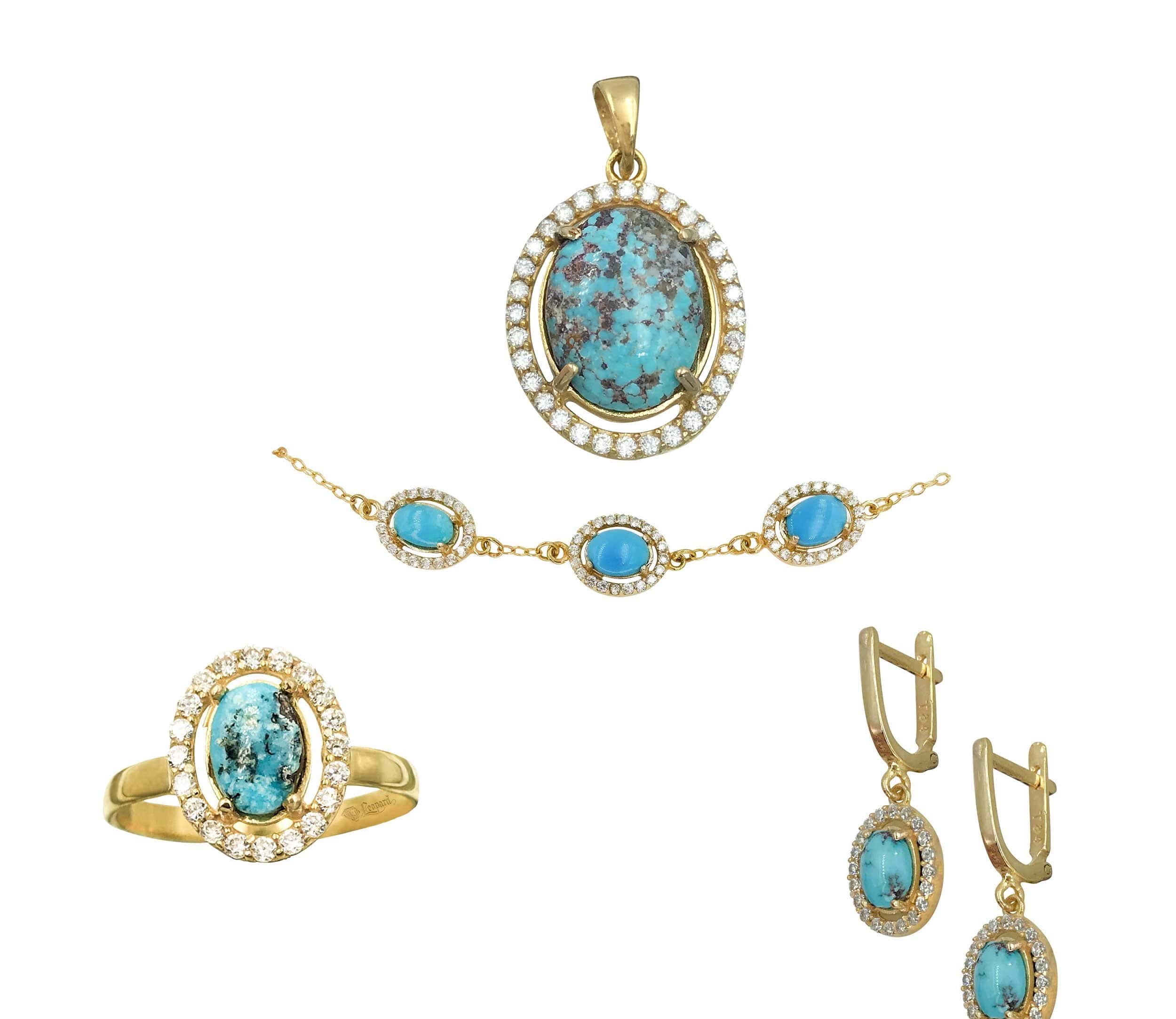
Gold and Turquoise Necklaces
Key Jewelry Pieces
- Gold and Turquoise Necklaces: Brides in Shiraz often wear gold necklaces featuring turquoise inlays. These pieces are inspired by Persian art and architecture, with turquoise symbolizing protection and spiritual clarity.
- Gemstone Earrings: In addition to turquoise, ruby and emerald earrings are popular choices for Shirazi brides. The rich colors of these stones are thought to symbolize passion, love, and prosperity.
- Gold Bracelets with Engraved Designs: Shirazi brides wear gold bracelets that feature engraved floral patterns or Persian calligraphy, reflecting the city’s artistic heritage.
Symbolism
In Fars Province, bridal jewelry is a reflection of the region’s connection to art and spirituality. The use of turquoise symbolizes protection and blessings, while the combination of gold and gemstones signifies prosperity and status.
Conclusion: The Diversity of Iranian Bridal Jewelry Traditions
The diversity of Iranian bridal jewelry traditions reflects the country’s vast cultural landscape, with each region offering its unique styles, materials, and symbols. Whether adorned with gold, silver, pearls, or semi-precious stones, Iranian brides wear jewelry that not only enhances their beauty but also carries deep cultural and symbolic significance.
At LetsGoYelo, we celebrate these rich traditions by offering a collection of handcrafted Iranian jewelry inspired by regional bridal customs. Explore our range of unique pieces and discover the perfect jewelry for your special day, inspired by the timeless beauty of Persian bridal traditions!
